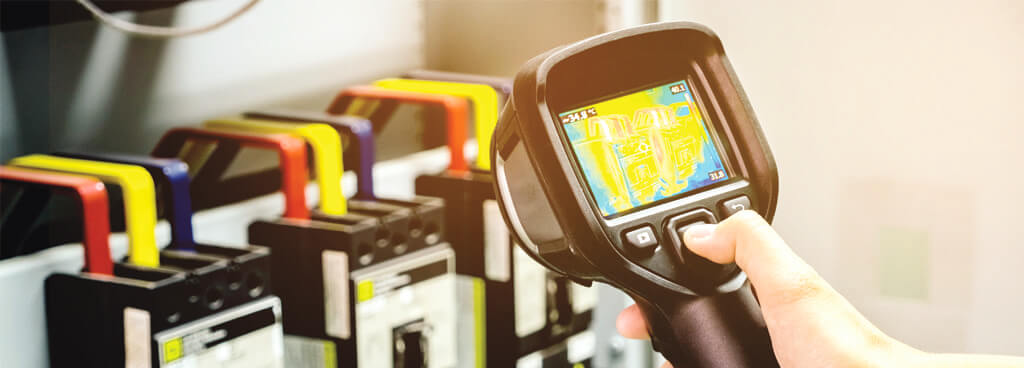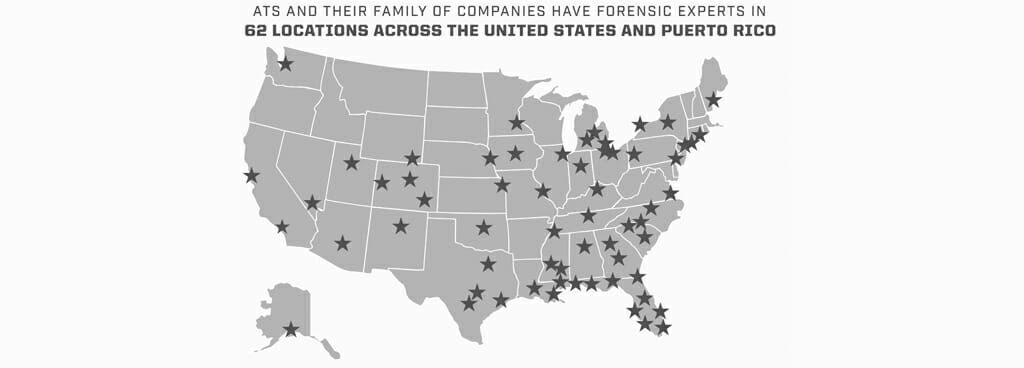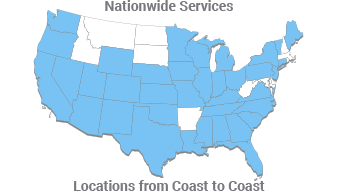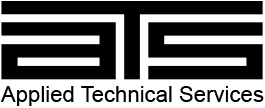- Home
- Services/IndustriesServicesindustries
- About Us
- LocationsStatesAccordion ContentAccordion ContentAccordion ContentAccordion Content
- Job Openings
- Quick Links
- ATS Family

What is Thermal Imaging?
Infrared imaging science is mostly known by other terms like Infrared Thermography (IRT), thermal video, and thermal imaging. Thermography cameras typically identify radiation in what is called the long-infrared series of the electromagnetic spectrum (9–14 µm or roughly 9,000–14,000 nanometers) and provide pictures, known as thermograms. All objects with temperature over absolute zero produce infrared radiation as stated by the black body radiation law, and thermography makes it feasible for us to see it.
To view and be able to measure schemes based on the differences in temperature, as minute as a few hundredths of a degree Celsius, an infrared thermographic scanner must be utilized. Depending on environmental conditions and the desired outcome, IRT testing may be executed or conducted during the day or night time. Engineers use it to trace or detect material not exposed to the surface of the ground, such as pipelines, pipeline leaks, hidden tunnels, Underground Storage Tanks (USTs), therefore looking for temperature models characteristically in the area of 0.01 °C to 1 °C below or above surrounding temperatures.
How Investigators Use Thermography
Thermography has been used for over five decades by many industrial and commercial arenas. Firefighters use thermography to localize the firebase, to find a person or to see through smoke. Maintenance personnel uses thermal imaging to detect high-temperature junctions and power lines sections, which are an indication of forthcoming or potential future failure. In the electrical field, irregular temperature models could specify a faulty connection. Building managers look for thermal indications that can point to leaks of heat in defective insulation areas, and use the inspection outcomes to increase the efficiency of their HVAC systems.
In addition, the detection of heat loss can discover other irregularities or abnormalities, like water penetration, humidity or moisture. Detection of moisture utilizing sing IRT is not restricted to buildings. It is also applicable to soil, paper, or even aircraft structures. Indications or existence of moisture inside the structure of an aircraft could lead to the formation of ice with a difference of volume, and mechanical stress consequences.
Thermograms (or thermal images) are in reality optical exhibits of the volume of infrared energy ejected, transmitted, and reflected by an item. Being careful when taking an image and by using the proper or correct camera settings, electrical systems can be skimmed and future failures can be identified. Imperfections or defects with steam traps in heating systems are easily located.
Advantages of the Method
- It is a non-destructive testing technique
- Suitable to find deterioration, i.e., higher temperature elements prior to failure
- Suitable for inaccessible or hazardous areas
- Suitable to find defects in pipes, plastics, shafts and other metal parts
- IRT is a non-contact technology: the source of heat is never in contact keeping the user out of danger
- IRT is in real time, therefore exceptional for fast-changing thermal patterns
- IRT has no harmful radiation effects as X-ray imaging, therefore better suitable for repeated and prolonged use
- IRT is a non-invasive technique, therefore it doesn’t affect the object in any manner
Thermography Standards
ATS professionals are committed to providing our clients with the highest quality thermal imaging inspections with timely results. ATS inspection services are within our Quality Systems and are in compliant with the following standards:
- Standard Practice for Thermographic Inspection of Insulation Installations in Envelope Cavities of Frame Buildings — ASTM C1060
- Standard Practice for the Location of Wet Insulation in Roofing Systems Using Infrared Imaging — ASTM C1153
- Standard Test Method for Detecting Delamination in Bridge Decks Using Infrared Thermography — ASTM D4788
- Standard Practices for Air Leakage Site Detection in Building Envelopes and Air Barrier Systems — ASTM E1186
- Standard Guide for Examining Electrical and Mechanical Equipment with Infrared Thermography — ASTM E1934
- Thermal insulation — Qualitative Detection of Thermal Irregularities in Building Envelopes — Infrared Method — ISO 6781
- Condition Monitoring and Diagnostics of Machines — Thermography — Part 1: General Procedures — ISO 18434-1
- Condition Monitoring and Diagnostics of Machines — Requirements for Qualification and Assessment of Personnel — Part 7: Thermography — ISO 18436-7


Request Form
"*" indicates required fields
Forensic Services
- 3D Laser Scanning
- Accident Reconstruction
- Accident Reconstruction Animation
- Accident Reconstruction Engineering
- Accident Reconstruction Experts
- Accident Reconstruction Services
- ACTAR - Traffic Accident Reconstructionist
- Arc Mapping
- Arson Investigators
- Asbestos Testing Lab
- Automotive Expert Witness
- Black Box Data
- Boilers, Vessels & Piping Failure Analysis
- Bosch Crash Data Retrieval
- Certified Arson Investigator
- Certified Fire Investigator
- Certified Forensic Expert
- Climate-Controlled Evidence Storage
- Construction Defect Expert Witness
- Construction Equipment Expert Witness
- Construction Expert Witness
- Crash reconstruction
- EDR Event Data Recorder Analyst
- Electrical Forensic Analysis
- Electrical Forensics
- Elevator Expert Witness
- Elevator Inspections
- Event Data Recorders
- Evidence Storage
- Evidence Storage Services
- Expert Witness Companies
- Expert Witness Services
- Explosion Investigations
- Farm Fire
- Fire Cause Analysis
- Fire Cause Investigation
- Fire Debris Analysis
- Fire Forensic Data Collection
- Fire & Forensic Investigation Updates
- Fire Investigation Company
- Fire Investigation Companies
- Fire Investigation Services
- Fire Investigator
- Fire Investigator Atlanta, GA
- Fire Investigation Expert Witness
- Fire Retardant Standards
- Fire Scene Investigaton
- Fire Scene Investigators
- Firearms Testing
- Forensic 3-D Site Scanning Service
- Forensic 3-D Scanning
- Forensic Accident Reconstruction
- Forensic Assignment Form
- Forensic Building Consultants
- Forensic Chemical Analysis
- Forensic Construction Expert
- Forensic Crash Specialists
- Forensic Electrical Engineer
- Forensic Engineering Consultants
- Forensic Engineering Expert
- Forensic Engineering Expert Witness
- Forensic Expert Witness
- Forensic Fire and Explosion Investigators
- Forensic Fire Investigation
- Forensic Fire Investigations
- Forensic Fire Investigation Services
- Forensic Imaging Specialist
- Forensic Lab Testing
- Forensic Locksmith
- Forensic Metallurgist
- Forensic Metallurgy
- Forensic Specialist
- Forensic Structural Engineer
- Forensic Structural Engineering
- Forensic Structural Engineering Firms
- Forensic Testing Service
- Forensic Thermal Imaging
- Forensic Tire Expert
- Forensic Water Damage Evaluation
- Forklift Expert Witness
- Golf Cart Expert Witness
- HAAG Certified
- Hail Damage Roof Inspection
- Handgun Testing
- Hurricane Structural Damage Evaluation
- Hurricane Structural Damage Inspection
- IAAI Certified Fire Investigator
- Incident Reconstruction
- Industrial Accident Investigation
- Infrared Thermal Imaging Services
- Joint Inspections
- Lap Shear Testing
- Large Loss
- Litigation Expert Witness
- Litigation Support
- Maritime Expert Witness
- Mechanical Forensics
- Natural Disaster Inspections
- Precision Forensic Testing
- Product Liability Expert
- Product Liability Expert Witness
- Secured Evidence Storage
- Special Services
- Speed Control Deactivation
- Structural Analysis
- Structural Fire Damage Assessment
- Structural Investigation
- Tire Failure Expert
- Traffic Accident Reconstruction
- Thermal Imaging
- Thermal Imaging Services
- Traffic Accident Reconstruction
- Truck Accident Expert Witness
- UTV/ATV Expert Witness
- Vehicle Fire Investigations
- Water Damage Inspection
